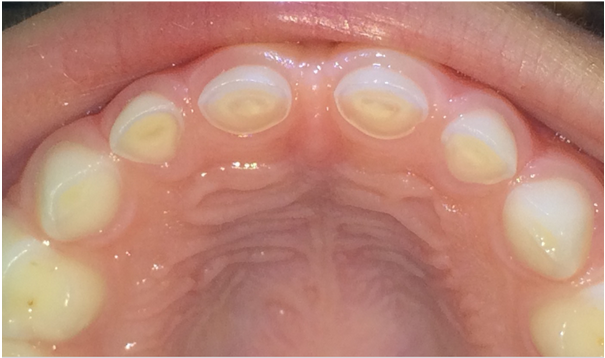Abstract
Aims: assess the prevalence, extent, severity, and distribution of erosive tooth wear (ETW) in preschoolers of Montevideo.
Methods: cross-sectional population-based study of representative sample of public and private educational centers. Sociodemographic, biological, and behavioral aspects were investigated with a self-reported questionnaire to parents / guardians. The examinations were performed by two examiners (Kappa ≥ 0.7).
The ETW was registered with modified O´Brien index, reported in percentage and average, confidence interval (CI) 95%. Analysis of association with sex and socio-economic level were carried out.
Results: 614 preschoolers were examined. Prevalence: 57.6% [95%CI=52.7-62.5]. Severe ETW: 8.2% [95%CI 5.5-10.9]. ETW extension: 4.8 [95%CI=4.3-5.3]. The most affected surfaces were palatal upper incisors. Preschoolers of high socioeconomic level presented higher ETW than those of low level; 73.1% (95% CI: 61.9-84.2) and 48.4% (95% CI: 39.2-57.7) respectively (≤0.01).
Conclusion: ETW prevalence and extent was high. These data can contribute to the modification of measures that aim to control ETW prevalence.
References
2. Murakami C, Oliveira LB, Sheiham A, Nahas Pires Correa MS, Haddad A. E, Bönecker M. Risk Indicators for Erosive Tooth Wear in Brazilian Preschool Children. Caries Res. 2011; 45(2)121–129.
3. Ranjitkar S, Smales RJ, Kaidonis JA. Oral manifestations of gastroesophageal reflux disease. Journal of Gastroenterology and Hepatology. 2012;27(1)21–27.
4. Murakami C, Tello G, Abanto J, Oliveira LB, Bonini GC, Bönecker M. Trends in the prevalence of erosive tooth wear in Brazilian preschool children. Int J of Paed Dent. 2016;26(1):60–5.
5. Schlueter N, Jaeggi T, Lussi A. Is Dental Erosion Really a Problem? Adv Dent Res. 2012;24(2):68–71.
6. Kreulen CM, Van´t Spijker A, Rodriguez JM, Bronkhorst EM, Creugers NHJ Bartlett DW. Systematic review of the prevalence of tooth wear in children and adolescents. Caries Res. 2010; 44:151–9.
7. Luo Y, Zeng XJ, Du MQ, Bedi R. The prevalence of dental erosion in preschool children in China. J Dent. 2005; 33:115–121.
8. Nakane A, Sasaki Y, Miwa Z, Kitasako Y, Tagami J. Prevalence of dental erosion and related factors in the deciduous dentition of Japanese children. Pediatric Dental Journal. 2014; 24:97–105.
9. Chadwick BL, White DA, Morris AJ, Evans D Pitts NB. Non- carious tooth conditions in children in the UK, 2003. Br Dent J. 2006; 200:379–84.
10. Pitts N, Chadwick B, Anderson T. Children’s Dental Health Survey 2013. Report 2: Dental Disease and Damage in Children England, Wales and Northern Ireland. Leeds: Health & Social Care Information Centre; 2015.
11. O´Brien M. Children´s dental health in the United Kingdom 1993: Her Majest´s Sationery Office. 1994.
12. Millward A, Shaw L, Smith A. Dental erosion in four-year-old children from differing socio-economic backgrounds. ASDCJ Dent Child. 1994; 61:263–6.
13. Tao DY Hao G, Lu HX, Tian Y, Feng XP. Dental erosion among children aged 3-6 years and its associated factors. Journal of Public Health Dentistry. 2015; 75:291–7.
14. Mangueira DF, Sampaio FC, Oliveira AF. Association between socioeconomic factors and dental erosion in Brazilian schoolchildren. Journal of Public Health Dentistry. 2009;69(4):254–9.
15. Alvarez L, Fabruccini A, Severo L, Alvarez R Maltz M. Erosive Tooth Wear among 12-Year-Old Schoolchildren: A Population-Based Cross-Sectional Study in Montevideo, Uruguay. Caries Res. 2015; 49:216–25.
16. Shaik R. Dental erosion in primary dentition-a review. J Evid Based Med. 2017;4(50):3070–6.
17. Llambí C; PL. Índice de Nivel Socioeconómico (INSE). http://www.cinve.org.uy/informesproyectos/indice-de-nivel-socioeconomico-inse/. 2012.
18. Bordoni N MC. Índices Epidemiológicos para Realizar Diagnóstico de Situación Dental. Preconc, Organ Panam la Salud. 1992.
19. R Foundation for Statistiacl Computing, Vienna AU https://www. R org/). R: A language and environment for statistical computing. (R Core Team 2017).
20. Mantonanaki M, Koletsi-Kounari H, Mamai-Homata E, Papaioannou W. Dental erosion prevalence and associated risk indicators among preschool children in Athens, Greece. Clin Oral Invest. 2013;17(2):585–93.
21. Berg-Beckhoff G, Kutschmann M, Bardehle D. Methodological considerations concerning the development of oral dental erosion indexes: literature survey, validity and reliability. Clin Oral Invest. 2008;12(SUPPL.1):51–8.
22. Taji S, Seow WK. A literature review of dental erosion in children. Aust Dent J. 2010;55(4):358–67.
23. Luo Y, Zeng XJ, Du MQ Bedi R. The prevalence of dental erosion in preschool children in China. J Dent. 2005; 33:115–121.
24. Vellore KG. The prevalence of dental erosion in 5-year-old preschoolers in Sharjah, United Arab Emirates. Eur J Dent. 2016;10(2):215–9.
25. Wiegand A, Müller J, Werner C, Attin T. Prevalence of erosive tooth wear and associated risk factors in 2-7-year-old German kindergarten children. Oral Diseases. 2006;12(2):117–24.
26. Rios D, Magalhaes AC, Honorio HM, Buzalaf MA, Lauris JR. The prevalence of deciduous tooth wear in six-year-old children and its relationship with potential explanatory factors. Oral Health Prev Dent. 2007;5(3):167–71.
27. Richards D. Impact of diet on tooth erosion. Evid Based Dent. 2016;17(2):40.
28. Instituto Nacional de Estadística. Encuesta Nacional de Gastos e Ingresos de los Hogares 2016-2017. https://www.ine.gub.uy/c/document_library/get_file?uuid=3b50400d-c42f-44e7-83a6-339f30798068&groupId=10181. 2017.
29. Gatou T, Mamai-Homata E. Tooth wear in the deciduous dentition of 5-7-year-old children: risk factors. Clin Oral Invest. 2012;16(3):923–33.
30. Raza M, Hashim R. Dental erosion in 5- and 6-year-old school children and associated factors: a pilot study. J Int Dent Med Res. 2012;5(1):36–40.


